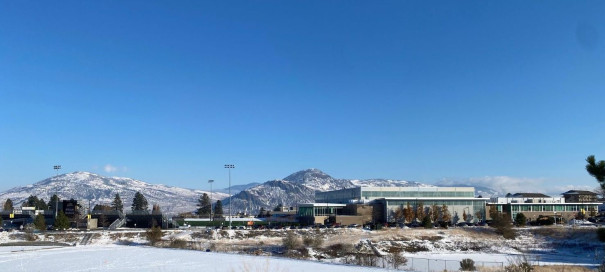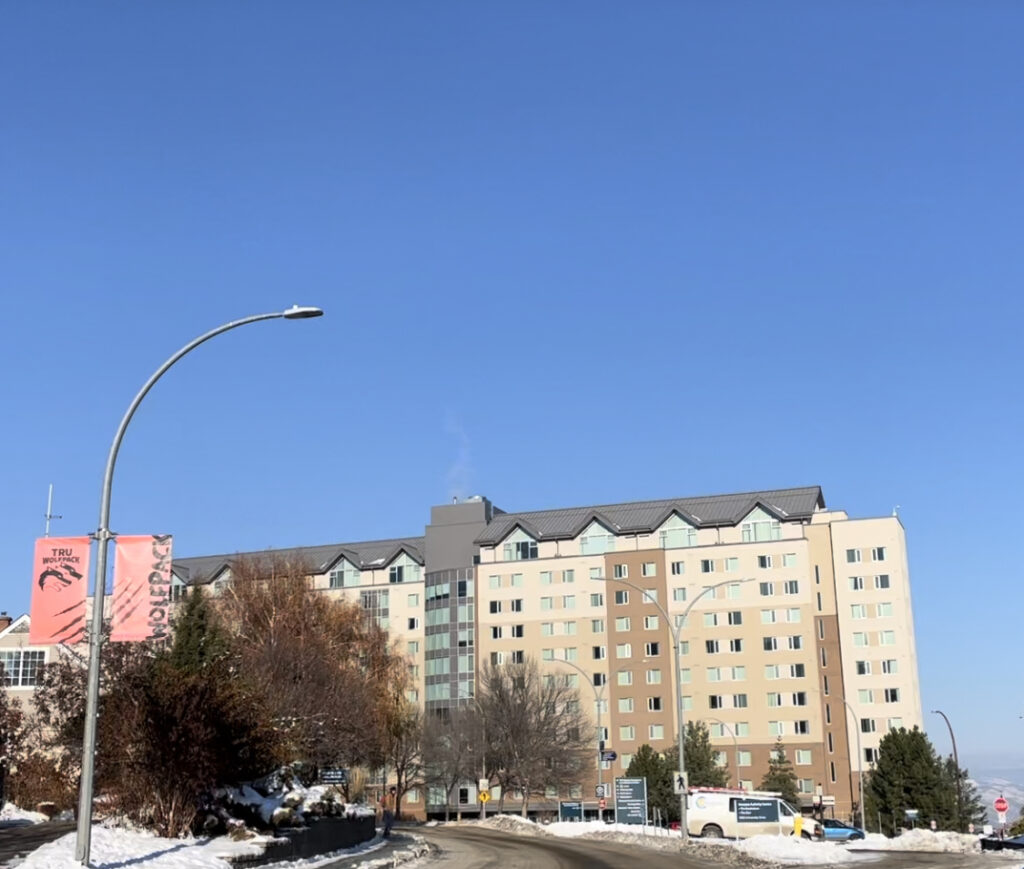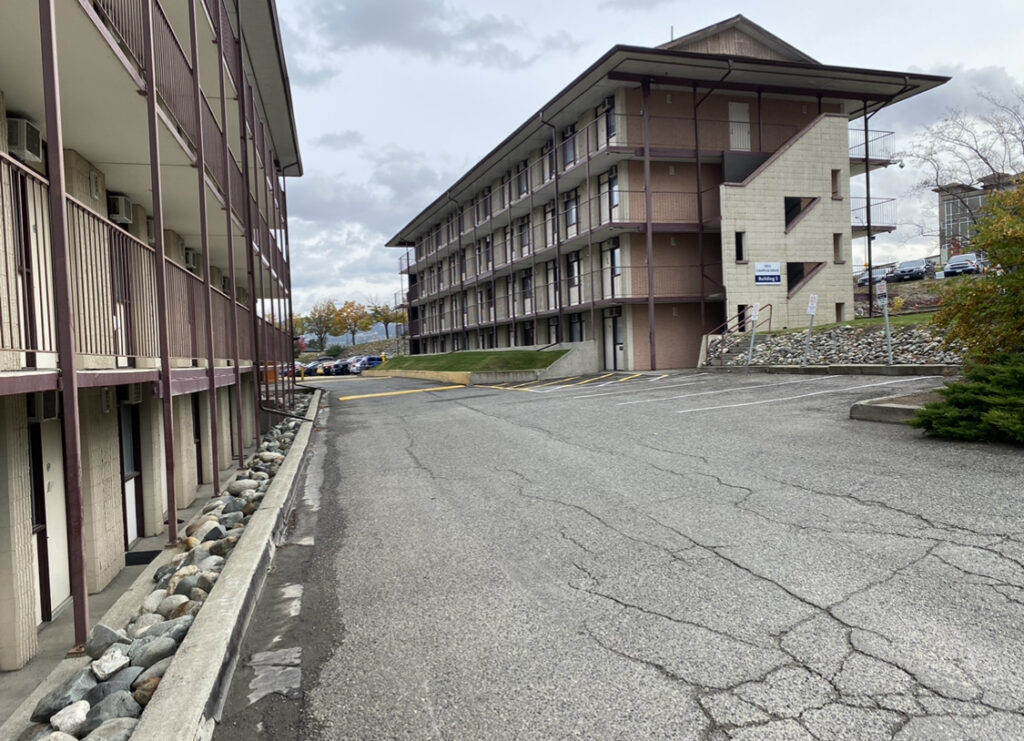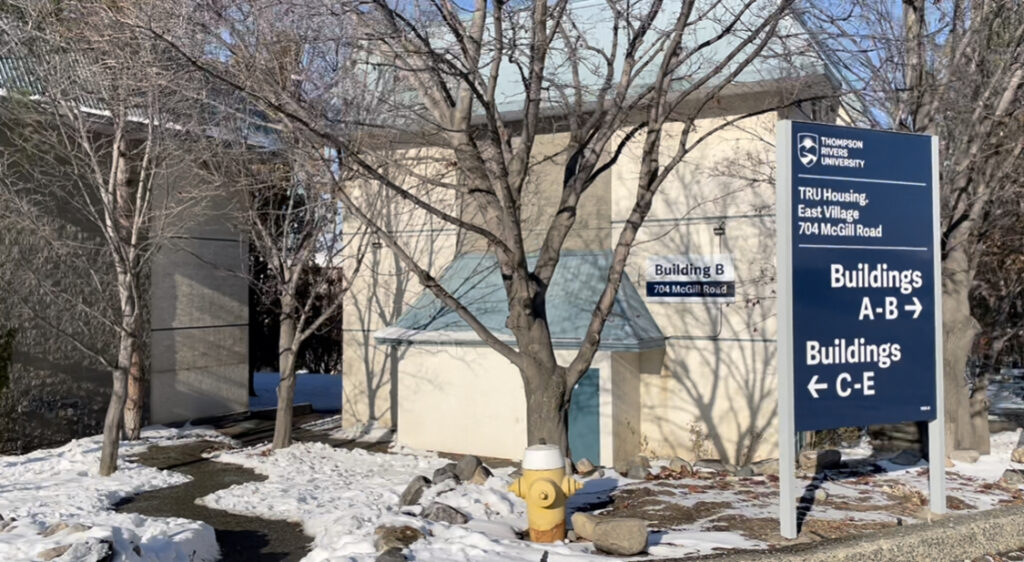On-Campus Student Housing
Category: Non-Market Rental | Author(s): Kirstynn De Cicco and Nicole Levesque

Image Credit: Thompson Rivers University, West Gate Entrance. Photo By: Kirstynn De Cicco
Location Address: Thompson Rivers University, Tru Way, Kamloops, BC, Canada
Subject
As of 2018, the City of Kamloops Affordable Housing Summary reported that 46.8% of Kamloops residents do, in fact, rent housing rather than own their homes (City of Kamloops, 2018). Meaning nearly half of Kamloops residents are not homeowners. Many of Kamloops residents who fall under the non-market rental housing category are TRU students. With the ever-growing attendance of the university and more students hoping to study in Kamloops each year, the demand for student housing is increasing faster than it can be built.
Currently, Thompson Rivers University (TRU) has four on-campus residences. It provides an off-campus Homestay program in which 450 carefully selected families host live-in students and provide them with three meals a day as well as a furnished living space during the student’s studies. TRU’s four on-campus residences include East Village, McGill Residences, North Tower, and recently as of 2021, the West Gate Dormitories. Collectively, the on-campus residences provide 1,486 beds and the off-campus homestay program 450 beds, providing a total of 1,936 beds for TRU students of Kamloops. The university has been working hard to accommodate more students; however, the student population is increasingly growing as TRU has transitioned from a commuter-style campus into a lifestyle campus. When speaking with TRU, President Brett Fairbairn revealed that it is quite difficult for universities within B.C. to build student housing as universities must pay out of pocket for such developments. Currently, there are no standard nor consistent means of government lending for B.C. universities to borrow funds for building student housing, as B.C. universities are not allowed to borrow money without government approval. For student housing units to be rented out at below-market rates, the construction of student housing must be subsidized. The current means of available student housing funds are limited through using university subsidies out of accumulated surpluses of operations and/or through receiving a grant. Fairbairn continues, “TRU has had to be very creative when finding ways to fund new student housing.” Within the last five years, the government has committed resources for TRU to build on-campus residences such as the East Village. However, until 2021, TRU did not believe that they had a housing crisis; therefore, the university did not apply for additional funding. Now that the student population and the demand for on-campus housing are increasing steadily, students often face availability issues and waitlists when applying for on-campus residence.
Crisis
TRU’s 2021-2022 Factbook demonstrates the Kamloops campus student headcount trends from 2017-2022. From 2017 to the fall of 2020, the student headcount remains at just over 15,000 students. From the beginning of 2020 to the end of 2020, after the pandemic, the Kamloops campus headcount remains in the mid-13,000s. Thus, from 2017-2022, the TRU Kamloops campus has seen an average of 14,489 students per year for the last five years. The gap between 14,489 students and the available beds is quite large. However, it is essential to note that not all TRU students seek student housing. Although, for 2022 alone, 13,638 students attended TRU with only 1,936 available beds. Thus, even if a quarter of this year’s students sought student housing, just over 1,400 students would be left to seek accommodation elsewhere. TRU Residence Life Manager, Brandon Jodoin, estimates that this fall, potentially 2,500 students applied for on-campus housing and perhaps 1,000 students did not make it off the waitlist. Jodoin recalls the waitlist for housing this fall to have approximately 600-700 students. Gender plays a role in the availability of on-campus housing currently, as all TRU student housing is gendered, male and female. Within a quadrant, genders are separated when the number of males and females do not match the number of beds; sometimes, beds within a quadrant may remain vacant as genders cannot be living co-ed. Jodoin explains that the residence community has observed an appetite for a conversation concerning gender-inclusive dorms. Moving forward would require “ensuring all parties are on board, being that the institution, the student population and the residence community.”
In addition to availability issues, students face the affordability of renting in Kamloops. The City of Kamloops’ Affordable Housing Summary (2018) states that “Housing affordability for those earning minimum wage is $657 per month” (p.1). The summary concludes that 46.8% of those renting in Kamloops are spending more than 30% of their monthly income on shelter alone, while “housing is said to be affordable when no more than 30% of a household’s income is spent on shelter costs” (City of Kamloops, 2018, p.1). The pressures Kamloops is experiencing within the rental market have rippling effects on student housing. TRU offers a wide range of housing in terms of cost. Students typically pay for an academic semester and 8 months of rent. Currently, students must pay within one or two payments; monthly rent payments are not available at this time for on-campus student housing. The lowest housing cost per academic semester is $3,909 at the East Village residence for a four-bed, two-bedroom shared suite. The highest student housing cost per academic year is $9,080 at the North Tower for a one-bedroom suite. The average monthly cost of TRU’s seven available on-campus student housing price packages is $821.57. If students are able to study and work, earning minimum wage, the average monthly cost of student housing of $821.57 is still above what Kamloops considers to be affordable housing for a single person of $657 per month. Student housing is affordable compared to the current community rental market; however, Kamloops is experiencing a housing crisis which can drive up housing costs within all aspects of the community.
Video Credit: Shot and Edited by Kirstynn De Cicco and Nicole Levesque
Community Implications
The community should be interested in student needs and their challenges when seeking student housing because the community continues to thrive when students thrive. Students play an active role as community members, contributors to the local economy, and support the work industry as they seek employment within the city. Suppose students who wish to live on campus do not sneak past the waitlist. In that case, they may seek shelter within the community, thus having further implications on the already struggling market rental community. Andrew Petter, (2022) former president of Simon Fraser University, argues, “Providing more student housing on university and college campuses across the province addresses both problems, freeing up affordable rental housing in the community and providing students with suitable on-campus accommodation while they gain the knowledge and skills required to achieve their full potential” in his recent article Student housing on campuses key to addressing rental housing shortage with The Vancouver Sun. When students cannot find a home anywhere in Kamloops, they cannot contribute and thrive within the community and be forced to carry out their studies elsewhere. TRU Residence Life Manager Brandon Jodoin comments that if students are struggling, that may cause further limitations within the community, and “if we are going to have students here, we need to support them.”
Click or press on images to expand.
A Way Forward
We recognize that no one suggestion will solve the housing crisis in Kamloops, but based on our research, here are some ideas that may help move us even slightly forward.
When working towards potential solutions, there is an opportunity for the TRU Residence community to explore providing some gender-inclusive housing to avoid empty beds when the number of males and females do not fit neatly into the number of available dorms. TRU World and TRU Residence could work together in researching the demand for gender-inclusive student housing through surveys and consider evolving some buildings or current sectors of existing student housing to gender-inclusive spaces. TRU Residence could also consider advertising specific assistance plans or offers for students who find lump sum payments difficult or impossible when seeking to live on campus. Allowing the current assistance for students to become visible and more consistent. Perhaps monthly payment programs may assist students living paycheck to paycheck in terms of affording to live on residence. At a government level, B.C. Housing and the government of B.C. should work together to consider providing some standard and consistent forms of financial support or loans for universities to make it easier to build more student housing.





